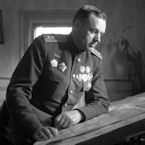golden delicious
Posts: 5575
Joined: 9/5/2000
From: London, Surrey, United Kingdom
Status: offline

|
Prompted to post this here from another thread. This represents my musings on the subject based on experience rather than specific test results, feel free to disagree or highlight outright errors.
For any given map scale, there's typically a choice of time scales which might be appropriate, e.g. at 10km/hex you could opt for one-day turns or half-week turns [I originally wrote this article thinking of TOAW III, I'm aware there are other choices]. The game obviously adjusts movement rates accordingly but that's about it, and the choice actually has an enormous effect on the scenario. It's possible to make two scenarios with the same map and OOB, some slight tweaks to events and replacements, but which will play out radically differently based on the time scale selected.
Some of the factors:
Combat: If there are half as many turns, there are necessarily going to be fewer combats, but not half as many as you're likely to have a better chance of getting your units into combat on any given round if the units have more move. However this effect is less pronounced for artillery (provided they have the range) and airpower, which are likely going to be able to blast away every round regardless of the turn scale. This makes those arms more significant if the turn length is shorter.
Fluidity: It's an IGO-UGO system, so if you double the turn length you're doubling the lag between action and reaction. If we're looking at half-week turns, then the attacker in theory has three times as long to create and exploit a breach in the line before his opponent can effectively react versus one-day turns. This is even more severe if you're dealing with a fluid situation and manoeuvre is already dominant: if my panzer division has a move of 32 it can swing around an open flank and get right into your rear all in one turn. This is bad news for an outnumbered defender trying to withdraw. It also seems that, all else being equal, units entrench at a more or less consistent rate in a given turn, regardless of how long that turn is. As such, units will be able to fortify their positions faster if the turn length is shorter. This further contributes to reduced fluidity- and is a compounding factor increasing the significance of artillery which is vital for breaking a fortified position.
Supply: If a unit has half as much move, it will use less supply- although this is not a linear relationship since as above the unit will probably engage in fewer combats too. What's also critical is that units which are cut off from supply are assumed to be cut off for the entire turn: and the effects of being unsupplied scale directly with the turn length. A unit cut off for a week loses double the supply and equipment of a unit cut off for a half week turn. This is a nasty one: we've already established that longer turns make it more likely that your units can be cut off before you can do anything about it, now we know that if that happens you pay twice the price. Conversely with a consistent supply rate, the larger number of combat rounds in a larger number of turns (especially for artillery) can be quite sustainable. It's also notable that there's a penalty to supply recovery for units that moved in the turn: clearly, it's more likely that a unit will move in one full-week turn than in both of two half-week turns, so in the latter case this penalty is less severe.
Reserves: If I have a strategic reserve, it typically takes two turns to get into action: on turn one, it rides the rail to the front and on turn two it rolls up into the action. While both these legs of movement are going to be affected by scaled movement rates, I'd suggest that in most cases this two turn rule is pretty fixed. So depending on your turn scale it could take two days or seven for reinforcements to arrive. This is again a compounding factor on fluidity: the attacker is going to have finished demolishing the defences and will be deep in the rear area by the time the cavalry arrives if you've opted for the longer turn length. Moreover, the ability of the attacker to exploit is going to negate the increased movement rates in the longer turn scale: if that panzer division has 32 MPs I'm not going to bring entrained units right up behind the front line, I'll need to make sure to drop them off a good few hexes back so they don't get caught before they've had a chance to disembark. This is somewhat mitigated by the greater one-turn reach of local reserves which don't have to ride the rail, but if they land on the front with 0 or 1 MPs left that's not much consolation.
One could summarise all this to say that, with a short turn length combat and firepower are relatively more important, whereas with a longer turn length speed and manoeuvre will tend to dominate. I think if I was to make a design recommendation off the back of this, it would be to use this as a balancing factor: if you've a high density scenario where the players are wading through a sea of units every time they attack, a longer turn scale might be appropriate to stop the scenario bogging down. Conversely, if you're dealing with a situation in which there are relatively few units for the space and open flanks are the norm, a shorter turn scale might be important to prevent unrealistic encirclements.
It might also be appropriate in some cases to use the reduced reaction speeds imposed by longer turns to reflect historical paralysis, for example in my Poland scenario, the half-week turns ensure that the Poles really can't mount a coherent response unless the situation becomes well stabilised. This tool should be used with considerable care, however, as it cuts both ways: if we were looking at a more balanced campaign, such as France in 1940, this effect could be used by the Allies to outmanoeuvre the Germans in a way that really would be ahistorical.
I'll close with some of the variables one can set in the scenario to address these issues:
1) Force Supply: I think it stands to reason that supply levels must be lower in a scenario with shorter turn scales- but by less than 50%.
2) Attrition Divider: This is a really blunt instrument and should be used with extreme care. Anyone who's played Bob Cross' strategic scenarios where he has scaled the attrition divider to extremes will be familiar with the result this has, and in particular it doesn't seem to have much if any effect on the lethality of anti-armour weapons. Nevertheless, if you have a shorter turn scale it might be worth adjusting the attrition divider up by a couple of points (a higher divider = fewer losses)
3) Rail (and sea) capacity: Although units will not travel as far in a single turn, in most scenarios rail journeys will still be complete in a single turn, so rail capacity probably needs to be increased in inverse proportion to the number of turns. For the record the same will apply to various other factors like replacements, rail repair and pestilence
4) Cost for converting hexes: This is a tricky one, but clearly if the cost of converting enemy controlled hexes is lower than fluidity will be increased, and the reverse is also true. If you have longer turn lengths and that panzer division always manages to cut the rail line in one turn, you might consider increasing this level to slow its advance- but again this is a blunt instrument. It's also worth noting that this cost isn't paid by units which enter an enemy hex when advancing following an attack.
_____________________________
"What did you read at university?"
"War Studies"
"War? Huh. What is it good for?"
"Absolutely nothing."
|
 Printable Version
Printable Version










 New Messages
New Messages No New Messages
No New Messages Hot Topic w/ New Messages
Hot Topic w/ New Messages Hot Topic w/o New Messages
Hot Topic w/o New Messages Locked w/ New Messages
Locked w/ New Messages Locked w/o New Messages
Locked w/o New Messages Post New Thread
Post New Thread